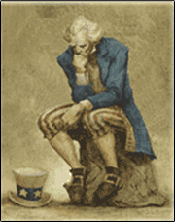Photo-colorizer gives smiles to the Khmer Rouge's victims
One of the big trends today is to colorize black and white images, a technique that brings them to life in an extraordinary way. Matt Loughrey has long been a leader in the field. However, Loughrey found himself in a minefield when he added smiles to colorized images he made from photos that the Khmer Rouge, which executed a quarter of Cambodia's population in the mid-1970s, took of the people it intended to murder.
Colorizing old photos is all the rage, so much so that there's even an app for it, which produces surprisingly sophisticated and accurate results. The best use I've seen of the colorizing technique was in Peter Jackson's truly extraordinary They Shall Not Grow Old. I can't recommend this movie highly enough, especially considering that most of the ills in the modern world can be traced back to World War I.
One of the best colorizers around is an Irish resident named Matt Loughrey. He has a business called My Colorful Past. In addition to colorizing family photographs that people commission, he also meticulously colorizes photos of famous people, a process that sees him make personal artistic choices rather than following a computer algorithm. The Daily Mail periodically showcases his photographs. If you follow the links, you can see examples of movie and Broadway stars from the late 19th and early 20th centuries, famous people from Jesse James to Mary Queen of Scots (whose death mask Loughrey colorized), and Australian convicts. Loughrey is talented.
At some point, Loughrey was commissioned to do some work with a tragic backstory. As you may recall, one of the things that the Khmer Rouge did at the infamous S-21 prison in Phnom Penh was to photograph its prisoners before murdering them. All told, Khmer Rouge agents tortured and executed an estimated 17,000 people. These photos are incredibly haunting, as ordinary people look to the camera knowing they soon will be executed.
Some of the relatives of the victims asked that Loughrey colorize their photographs. He did so, and often had the people shown smiling. This was an artistic choice, and the family members apparently did not object, perhaps preferring to see their relative looking happy:
In his interview with Vice [which Vice has since withdrawn], Loughrey said he had been hired by family members of some of the S-21 victims to colorize photos of their loved ones, and he then on his own worked on more images from the prison, which today is the Tuol Sleng Genocide Museum. The Associated Press was unable to reach him Monday for comment.
Several colorized photos accompanying the article showed S-21 prisoners smiling for the camera, and Loughrey volunteered his thoughts to Vice's interviewer about why they might have been smiling.
"The women tended to have a smile on their face more so than the men," he told Vice. "I think a lot of that has to do with nervousness."
Having done those commissioned pictures, Loughrey got fascinated by the subject and continued working with photos from the S-21 prison camp. Unfortunately, he kept showing those smiles.
Vice News didn't think anything of those smiles when it wrote an article about Loughrey's work bringing those black-and-white photos to life. However, as the AP article about the story explains:
The article set off alarms bells with people familiar with the collection of the original black and white photos, including professional photographer John Vink, who has worked in Cambodia. They pointed out that in at least some of the original photos, the subjects were not smiling, and Loughrey not only colorized the photos but retouched them to alter their expressions[.]
"Matt Loughrey in Vice is not colourising S21 photographs. He is falsifying history," Vink commented Saturday on Twitter, showing examples of the originals and Loughrey's altered versions with smiles.
Matt Loughrey in Vice is not colourising S21 photographs. He is falsifying history: pic.twitter.com/z6J99J7BOE
— John Vink (@vinkjohn) April 10, 2021
So @VICE ran an article with photo retoucher Matt Loughrey about images he colorized of victims of genocide in Cambodia. Not only did he colorize the images, he changed the expressions of the victims are created a bullshit narrative around it. Stunningly irresponsible stuff. pic.twitter.com/0gadODy5xN
— rob hoffman (@Rob_Hoffman) April 10, 2021
As noted, Vice has since removed the offending article, and Loughrey must now try to live down the scandal. Because I've admired his work for a long time, I'm loath to believe that he was intentionally trying to whitewash the Khmer Rouge. I'd like to think it's more likely that his artistic sensibilities, which he's brought to all his hand-done colorizations, severely impeded his good sense. Indeed, I hope that's the case and would be disappointed to learn otherwise.
Image: Matt Loughrey's Cambodian prison photo manipulation. Twitter screen grab.
To comment, you can find the MeWe post for this article here.





